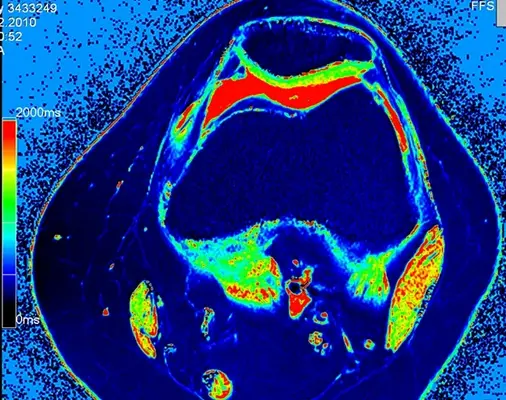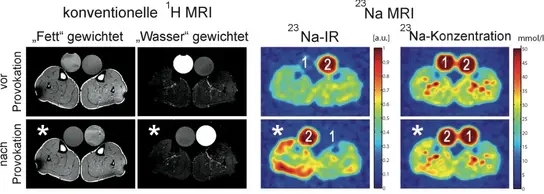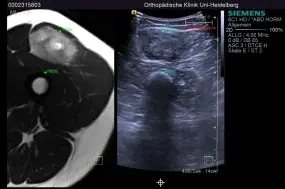Research Group Musculoskeletal Imaging
- High-field MRI for the evaluation of cartilage vitality and integrity
- Implementation of functional MRI methods for the assessment of normal and abnormal skeletal muscles
- High-field MRI in the diagnosis of cartilage tumors
- Imaging in monoclonal plasma cell diseases
- Fusion ultrasound (eSie) in the diagnosis of peripheral soft tissue tumors
- Selected publications
Overview
[autotranslated from German content]
The joint Musculoskeletal Imaging Working Group of the Radiology Division of the German Cancer Research Center and the Musculoskeletal Radiology Section of the Department of Diagnostic and Interventional Radiology (DIR) at Heidelberg University Hospital is concerned with the implementation of innovative methods for functional multimodal or large-volume musculoskeletal imaging of the musculoskeletal system in cooperation with the Medical Physics Division of the Radiology Department of the German Cancer Research Center.
The clinical and scientific focus of the Musculoskeletal Imaging working group is on establishing modern MRI and ultrasound techniques in cartilage, muscle, vascular and tumor diagnostics of the musculoskeletal system. In addition to the project-based collaboration, there has been a staff rotation between the Radiology division of the German Cancer Research Center and the Musculoskeletal Radiology section of the DIR since 2012.
High-field MRI for the evaluation of cartilage vitality and integrity

Contact: Dr. med. Christoph Rehnitz, Dr. rer. nat. Armin M. Nagel
In addition to high-resolution morphological imaging, there are new developments in modern imaging of articular cartilage that also make it possible to visualize the biochemical components of cartilage. These include the so-called dGEMRIC technique and T2 mapping. Some of these biochemical components play central roles in the development of osteoarthritis or in cartilage healing after cartilage therapy (including so-called glycosaminoglycans). The imaging and quantification of these components therefore allows conclusions to be drawn about cartilage vitality and integrity (Fig. 1). It can visualize changes that are not yet visible using conventional MRI methods. Current main areas of application are therefore: assessment of the functional condition of cartilage before surgery, follow-up examinations after cartilage therapy. Current projects are primarily aimed at evaluating the value of 7-Tesla MRI in these areas.
Implementation of functional MRI methods for the assessment of normal and abnormal skeletal muscles

Contact: Prof. Dr. med. M.-A. Weber, Dr. rer. nat. Armin M. Nagel
The usual radiological procedures can only visualize morphological changes in the muscles. New methods such as 23sodium magnetic resonance imaging now also show pathophysiological changes. For example, the calf muscles of patients with paramyotonia or hyperkalemic periodic paralysis (HyperPP), both diseases with intermittent paralysis caused by defective sodium channels in the muscles, can look completely unremarkable in a conventional magnetic resonance imaging scan. Only 23sodium magnetic resonance imaging is able to visualize the pathologically increased sodium content of the muscle cells (Fig. 2).
High-field MRI in the diagnosis of cartilage tumors

Contact: Dr. rer. nat. Armin M. Nagel, Dr. med. Björn Jobke
The incidence of benign cartilage tumors (enchondromas) is about 5%, so that incidental findings of this type are relatively common. In individual cases, the purely morphological differentiation of benign and less aggressive cartilage tumors (grade 1 chondrosarcomas) is extremely difficult and a challenge even for histopathology after sampling. Modern radiology can make a significant contribution here with high-resolution imaging, e.g. 7T high-field MRI, and show the growth behavior of the tumors in relation to the surrounding tissue. The aim is to show tumor invasiveness at the microstructure level, similar to histology.
(Kopie 1)

23Na is a component of glycoproteins, so-called proteoglycans, which play a decisive role in the formation of the cartilage matrix. The nucleus can be detected in high concentrations in healthy cartilage as well as in cartilage tumors, e.g. enchondromas, using high-field MRI. This project deals with the analysis of this 23Na concentration and its usefulness in the differential diagnosis and grading of cartilage tumors (Fig. 3) in collaboration with the division "Medical Physics in Radiology" (E020)
Imaging in monoclonal plasma cell diseases
Contact persons: Prof. Dr. med. Stefan Delorme, Dr. med. Jennifer Mosebach
The current projects are based on whole-body MRI and whole-body CT examinations of patients with monoclonal plasma cell diseases carried out both at the German Cancer Research Center and in the Musculoskeletal Radiology Section of Heidelberg University Hospital.
Fusion ultrasound (eSie) in the diagnosis of peripheral soft tissue tumors

Contact: Dr. med. Björn Jobke, Dr. med. Jessica Jesser, Prof. Dr. med. M.-A. Weber
A new ultrasound system (eSie, Acuson S3000, Siemens) is able to display images from other imaging procedures simultaneously with ultrasound images. It enables real-time ultrasound images to be superimposed or displayed in parallel with existing MRI and CT images of the same anatomical region. This so-called fusion imaging makes it possible to quickly orientate oneself anatomically and to obtain more detailed information for the diagnosis of complex issues or interventions, such as biopsies. A feasibility study is currently being carried out to assess the value of fusion imaging in the routine diagnosis of soft tissue tumors. Both technical aspects and the learning curve in handling the new technology play a role here, which should lead to system improvements in close cooperation with the manufacturer and developers, as well as primarily diagnostic aspects in the targeting of ultrasound-supported biopsies. The aim of a representative tissue biopsy of large, sometimes heterogeneous soft tissue tumors (here especially in soft tissue sarcoma of the extremities) is extremely important for diagnosis and grading.
Selected publications
3 Tesla sodium inversion recovery magnetic resonance imaging allows for improved visualization of intracellular sodium content changes in muscular channelopathies.
Nagel AM, Amarteifio E, Lehmann-Horn F, Jurkat-Rott K, Semmler W, Schad LR, Weber MA
Invest Radiol. 2011 Dec;46(12):759-66
Hyperkalemic periodic paralysis and permanent weakness: 3-T MR imaging depicts intracellular 23Na overload - initial results.
Amarteifio E, Nagel AM, Weber MA, Jurkat-Rott K, Lehmann-Horn F
Radiology. 2012 Jul;264(1):154-63
Bone tumors in 'Radiologische Diagnostik der Knochen und Gelenke' (Bohndorf, Jobke et al., 3rd edition, Thieme Verlag)